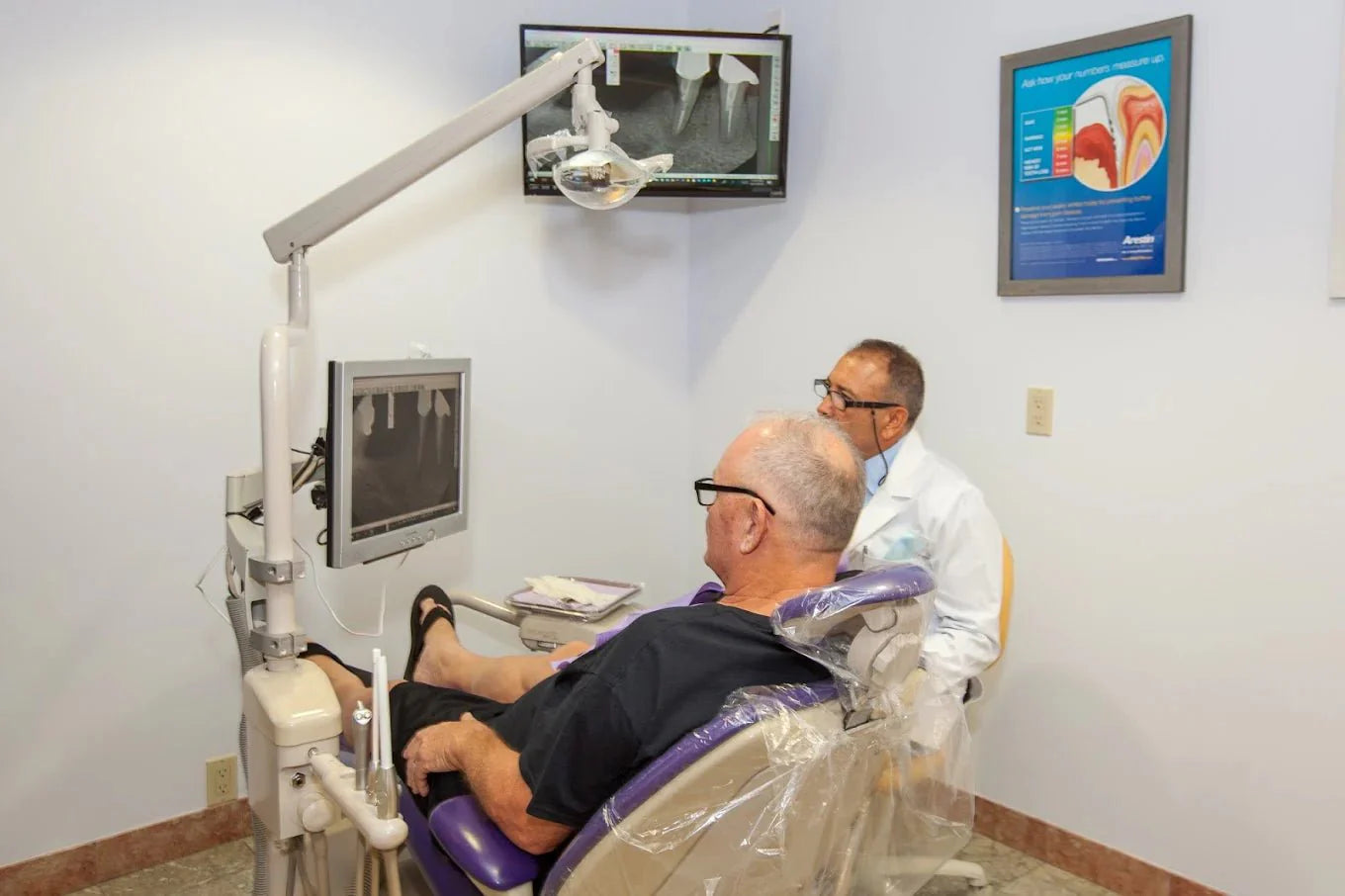Types of Dental Implants: Your Comprehensive Guide

With a 98 % success rate, many experts consider dental implants the golden standard in restorative dentistry.
There are different types of dental implants your dentist might recommend, though. And knowing the right type is essential for a successful procedure and optimal oral health. But don't worry, you don't have to figure it out alone.
In this article, we'll break down everything you need to know about the different types of dental implants, including their procedure, benefits, and drawbacks.
So, sit back, relax, and bring out your notepad because there's much to unpack here.
An Overview of the Different Dental Implant Types
There are three common types of dental implants: endosteal, subperiosteal, and zygomatic. And when you talk about these types, it isn't a matter of one implant being better than the other but of specific systems not being well-suited for a particular kind or case.
To expound on this matter, here’s an overview of the different types of dental implants.
Endosteal
Endosteal implants, also known as root-form implants, are artificial tooth roots surgically placed into the jawbone to support a prosthetic tooth or bridge.
These implants are typically made of titanium, a biocompatible material allowing them to fuse with the surrounding bone, creating a strong, stable foundation for replacement teeth.
Implantologists recommend endosteal implants when someone is missing one or more teeth and has enough healthy jawbone to support the implant. Other situations where these implants might be appropriate or recommended include:
- When the patient is seeking a solution that provides a more natural look than other tooth replacement options.
- If the patient is seeking a treatment that does not require the removal of healthy teeth, as is the case with some types of bridges.
Endosteal Implant Procedure
The procedure for placing endosteal implants typically involves the following stages:
First, you must consult a dental implant specialist to determine whether you are a good candidate for endosteal implants. This will likely involve a comprehensive dental exam, X-rays, and other diagnostic tests.
If you are deemed a suitable candidate, the next step is placing the implants into your jawbone. This procedure is usually done under local anesthesia and involves making a small incision in the gum tissue to access the underlying bone. The implant is then carefully inserted into the bone and secured in place.
After the implant is placed, there is a healing period of three to six months, during which the implant fuses with the surrounding bone. You will be given a temporary prosthetic tooth or bridge to wear during this time.
Once the implant has fully integrated with the bone, the final stage is to attach a custom-designed prosthetic tooth or bridge to the implant using an abutment. This prosthetic is designed to match your natural teeth and is securely anchored to the implant, providing a stable and long-lasting solution for tooth replacement.
Advantages
- Highly effective and durable solution for replacing missing teeth
- Provides a stable and secure foundation for prosthetic teeth or bridges, allowing for improved biting and chewing function
- Helps prevent bone loss in the jaw and maintain the overall structure of the face
- Fuses to the jawbone over time, thus, creating a secure connection that can support the weight of a replacement teeth
Disadvantages
- Can be invasive and may involve a lengthy healing period
- Requires sufficient bone density in the jaw, so patients with significant bone loss may not be candidates
- May cost higher than other tooth replacement options, such as dentures or bridges
Subperiosteal implants
While endosteal implants are fastened into the jaw, subperiosteal implants are placed below the gum but on top of the jawbone.
Subperiosteal implants consist of a custom-made metal framework to fit the shape of the patient's jawbone and a set of posts or screws that protrude through the gums to hold the replacement teeth or dental prosthetics.
They are typically recommended when an insufficient bone is available in the jaw to support traditional endosteal implants. Subperiosteal implants are a good option for people who have experienced significant bone loss due to conditions such as periodontal disease or tooth loss.
Subperiosteal Implant Procedure
There are multiple steps involved in placing these implants. The first step requires an impression of the jawbone using a CT scan or dental mold. This impression is then used to create a customized metal framework that is made from titanium or zirconia.
The next step involves making an incision in the gum tissue to expose the bone, then placing the metal framework on top of the bone and securing it using screws or other devices. It is crucial to position the framework correctly to ensure stability and a proper fit for artificial teeth or dental bridges.
Once the framework is secure, the dental appliance is attached to the posts or screws. These replacement teeth are designed to match the patient's natural teeth and function accordingly.
After the procedure, a two to eight-week healing period is necessary to allow the bone to fuse with the implant. During this time, the patient may wear dentures. Once the healing period is complete, the patient can receive a permanent set of teeth.
Advantages
- Suitable for patients with insufficient jawbone
- Less invasive as they do not require drilling into the jawbone. This can result in less discomfort and a faster recovery time.
- Can provide a stable and secure base for dental restorations such as crowns or bridges since these implants are placed on top of the jawbone
Disadvantages
- May only be suitable for some. For example, if a patient has significant bone loss or gum disease, subperiosteal implants may not be viable.
- There’s a higher risk of infection since subperiosteal implants are placed under the gum tissue.
- Tend to be more expensive than traditional implants, as they are custom-made for each patient and require specialized placement techniques
Zygomatic Implants
Unlike traditional dental implants placed directly into the jawbone, zygomatic implants are anchored into the zygomatic bone (also known as the cheekbone) and extend into the maxillary sinus, a hollow space behind the cheeks.
Using this longer implant makes it possible to avoid bone grafting procedures often required with traditional implants. Zygomatic implants are typically used in cases where the patient has experienced significant bone loss in the upper jaw due to factors such as trauma, periodontal disease, or prolonged denture use.
Zygomatic Implant Procedure
Zygomatic implants are a complex and advanced dental implant procedure typically performed by experienced and skilled dental implant surgeons. The following are the general steps involved in the implant placement procedure:
Before the treatment, the patient may undergo a comprehensive dental examination, including X-rays, CT scans, and other diagnostic tests to assess the condition of the jawbone and other oral structures.
Based on the dental examination and evaluation results, the dentist will develop a customized treatment plan that outlines the specific steps of the zygomatic implant procedure and addresses any unique challenges or considerations.
The procedure typically requires general anesthesia or IV sedation to ensure the patient is comfortable and relaxed.
After administering the anesthesia, the surgeon will make an incision in the gum tissue and create a small opening in the cheekbone to access the zygomatic bone. The bone is then prepared by creating a channel or pathway where the implant will be inserted.
The zygomatic implant is carefully placed into the prepared pathway in the cheekbone, with the implant extending into the maxillary sinus. The implant is then anchored securely in place.
Advantages
- Allow placement of dental implants in patients who have severe bone loss in the maxilla
- Can provide immediate support for a temporary tooth or bridge
- Eliminate the need for bone grafting, which can be a more invasive and time-consuming procedure
Disadvantages
- More complex and technically demanding procedure than traditional dental implants
- Carry a higher risk of complications, such as nerve damage or sinus perforation
- More expensive than traditional dental implants
Related Implant Procedures and Techniques

If you're having trouble supporting implants and a Zygomatic implant isn't an option either, your implantologist may suggest other options.
Bone grafting
One possibility is bone augmentation (bone grafting), where your dentist restores your jawbone if it can't support implants. Modern medicine has made it possible for doctors to stimulate the growth of bone in the needed areas.
This process involves using bone additives to strengthen the bone, which might sound futuristic but can be effective.
Sinus lift
Another option is a sinus lift (sinus elevation), which involves adding bone beneath the sinus if the bone has deteriorated due to missing teeth.
If your jaw isn't wide enough for implants, your dentist may suggest ridge expansion, which involves grafting material onto the top of your jaw.
3D Imaging
In circumstances where none of these techniques is feasible, your dentist might recommend 3D imaging to create a model of your jaw, which can help them plan the best implant procedure. This can save you money and speed up your recovery time.
Mini Implants
Mini dental implants (MDIs) are like any other type of implant but of small diameter implants. They also support dental prostheses, such as dentures or bridges. They are typically less than 3mm in diameter and 15mm in length and are made of titanium or titanium alloy.
MDIs are designed to provide a minimally invasive and cost-effective alternative to traditional dental implants. Mini dental implants can be used to:
- Support removable or partial dentures, especially in cases where traditional implants are not feasible due to a lack of bone density or other health factors.
- Replace a single missing tooth, particularly in cases where the adjacent teeth are healthy, and the patient is not a candidate for traditional dental implant placement.
- Support a dental bridge in cases where the natural teeth on either side of the gap are not strong enough to support a traditional bridge.
Mini-Implant Procedure
The mini-implant procedure involves several stages:
First, the dentist examines the patient's mouth to determine the suitability of mini dental implants.
If the patient is eligible, the dentist numbs the area where the implant will be placed using a local anesthetic, drills a small hole into the jawbone to accommodate the implant, and screws the MDI into place using a special tool. The surrounding gum tissue is then sutured closed.
Finally, the patient is instructed on caring for the new implant and may be given a temporary prosthesis while the implant heals.
In contrast to traditional implants, which require a healing period of approximately three weeks for incisions to heal, (or up to six months if a bone graft is necessary), mini dental implants do not require any downtime. In fact, a mini dental implant specialist can place the implant and attach a tooth or secure dentures in a single visit.
Advantages
- Placing MDIs is typically less invasive than traditional implants, which can lead to faster healing time and reduced discomfort
- Cost-effective
- Because MDIs are smaller in diameter than traditional implants, they can be placed in areas with a limited bone density that wouldn’t be suitable for larger implants
Disadvantages
- May not provide the same level of stability as traditional implants, particularly in cases where they are used to support a larger prosthesis
- Can have a shorter lifespan compared to traditional implants
- May not be for all patients, particularly those with more complex dental needs or underlying health conditions
All on 4 Dental Implants

As you lose multiple teeth, your jawbone can start to deteriorate. While dentures can help you temporarily restore your ability to eat, talk, and smile, they don't offer a permanent solution.
And as your bone structure changes, dentures may no longer fit properly. All-on-4 implants, on the other hand, offer continuous support, while preventing further bone loss and providing a stable long-term solution for missing teeth.
All-on-4 dental implants are a way to replace all of someone's upper or lower teeth by putting four dental implants in their jawbone. This is a good option for people who have lost all their teeth, and it's quicker and less expensive than other dental implant procedures.
All-on-Four Dental Implant Procedure
Like any other implant procedure, this technique begins with a thorough examination of the patient's teeth and jawbone to ensure they are suitable for the dental process. If necessary, bone grafting may be performed to build up the jawbone.
Once the jawbone is prepared, the four implants are inserted at strategic locations, typically angled to provide maximum support. The implants are then left to fuse with the jawbone over several months. In the meantime, a temporary denture is fitted over the implants, allowing the patient to chew and speak normally.
Once the implants have successfully bonded with the jawbone, the temporary tooth is replaced with a customized, permanent set of teeth that closely resemble the patient's natural teeth.
Advantages
- Fewer implants are needed, resulting in a quicker and less invasive procedure
- Cost-effective compared to traditional implant procedures
- Reduces the healing process and less discomfort
- Helps improve chewing and speaking ability
- Installation of teeth replacement can be done in a single day
Disadvantages
- Speaking may be difficult at first but improves with practice
- Initial tenderness may make speaking or chewing painful, but it eventually fades
- Implants come with multiple porcelain caps, which may feel strange when flossing
Choose the Most Trusted Dentist in Culver City, CA
Now that you’ve learned about the different types of dental implants, it’s time to restore that smile. Whether you opt for endosteal, subperiosteal, or zygomatic implants, choosing an experienced and qualified dental professional will ensure the success and longevity of your implant.
By researching and consulting with a trusted implantologist, you can find the right type of implant for your unique needs and enjoy a normal, healthy smile for years to come.
If you live in Culver City, California, or its adjacent cities (Santa Monica, Inglewood, or Marina Del Rey), finding the best dentist to help you with your implant needs won’t be that difficult.
Visit us at Culver City Dentist United Dental Care.
With state-of-the-art technology and our commitment to your comfort and satisfaction, we can help you bring back your smile to near perfection. Don't wait any longer to build confidence and improve your oral health.
Schedule your appointment with Culver City Dentist United Dental Care today!






